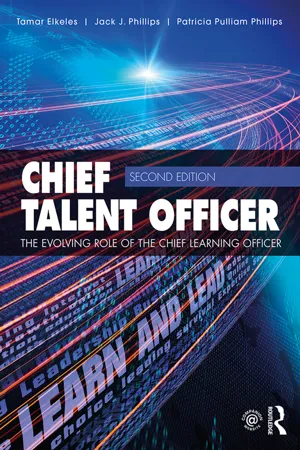
Chief Talent Officer
The Evolving Role of the Chief Learning Officer
- 322 pages
- English
- ePUB (mobile friendly)
- Available on iOS & Android
About This Book
In the face of rapid changes and challenges to the business environment, learning and talent are key to the success of businesses. This is an area in which the Chief Learning Officer (the CLO) is vital and has evolved into a Chief Talent Officer role in organizations. The Chief Talent Officer is now responsible for working to drive value, focusing on issues such as talent, organization design and development, culture, business alignment, managing resources, innovation, technology, utilization, customer service, and ROI. Chief Talent Officer discusses the critical, value-adding role of the next generation CLO, and the strategies that can be used to fulfill this role. With a wealth of perspectives from some of the world's best talent executives, this book illuminates the role from the CLO's perspective.
This revised and refreshed edition of the text includes the latest illustrative examples, explanations, and data. The reader is shown the role of the CLO from diverse, multinational points of view, and taken through the varying aspects of business strategy in a range of international environments.
This book is a vital tool for managers and students, providing techniques and methods for the training, talent, and HR communities alike. It will help its readers to demonstrate and understand the potential value that can be added to any organization when it is managed and organized well, and equipped with appropriate leadership.
Frequently asked questions
1
The chief talent officer
Opening stories
The changing role of the CLO
Learning is the business at ADP
The role of the CLO
Challenges and changes


- Technology on the rise. Organizations have been using technology for several decades as an efficient and effective way to deliver learning to the workforce. Increasingly, these organizations are delivering content to learners on mobile devices, through games, or on platforms that help learners consume content in an engaging and memorable way. Blending delivery methods for learning continues to be a focus for many talent development functions.
- Building a strong talent pipeline. Skills shortages in the existing workforce combined with the pending retirement of leaders and managers continue to affect organizations’ talent pipelines. These realities are compounded by demographic changes, with an increasing number of millennials coming into the workforce and global organizations managing dispersed talent all over the world.
- Talent development professionals as strategic business partners. Talent development professionals are responsible for a portfolio of functions across the breadth of the field. From instructional design to training delivery, change management, coaching, learning technologies, and 34 additional functions, individuals who lead and manage talent development are increasingly becoming trusted and relied upon as strategic business partners who help improve performance and achieve impact for the organizations they serve.
- Building a global workforce that can solve problems and innovate. As organizations continue to grow and expand their global footprint, senior leaders require their workforces to be knowledgeable and skilled, and to understand how to address problems with creative solutions. This continues to be top of mind for CEOs: In IBM’s 2012 study, Leading Through Connections, more than half of the surveyed CEOs and senior leaders in the private and public sectors saw human capital, customer relationships, and innovation as key sources of sustained economic value.4
- Developing partnerships that drive value. One of the three imperatives that the IBM study’s CEOs and senior leaders identified as essential for creating greater economic value and outperforming their peers was the notion of “amplifying innovation with partnerships.”
Top executive input

Table of contents
- Cover
- Half Title
- Title
- Copyright
- Contents
- Expanded table of contents
- Figures and tables
- Preface
- Acknowledgements
- Author biographies
- Foreword from Norm Kamikow (from the first edition)
- Tribute to Norm Kamikow – Tamar Elkeles
- Foreword from Mike Prokopeak – Editor, Chief Learning Officer magazine
- Foreword from Tony Bingham – CEO, ATD
- Foreword from Peter Cheese – CEO, CIPD
- In the beginning …
- 1 The chief talent officer: evolution, trends, and opportunities
- 2 Developing the strategy
- 3 Setting the investment level
- 4 Aligning learning to business needs
- 5 Shifting to performance improvement
- 6 Creating value-based delivery
- 7 Managing the learning function for value
- 8 Working in a global environment
- 9 Managing talent for value
- 10 Creating a performance and innovation culture
- 11 Creating value with employee engagement
- 12 Developing global leaders
- 13 Demonstrating value with analytics and ROI
- 14 Developing effective business relationships
- Index